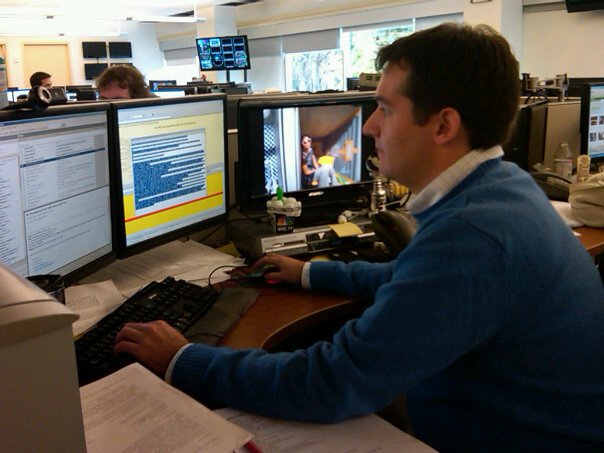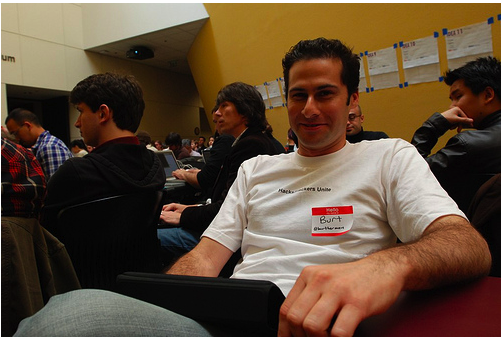Archive for the “Tech Blog (Guest Speaker)” Category
 David Lee, the co-founder and creative director of Projeqt.com, was supposed to be with us in class today, but wasn’t able to. Rick Reo, though, an instructional designer for GMU’s Division of Instructional Technology, was! David Lee, the co-founder and creative director of Projeqt.com, was supposed to be with us in class today, but wasn’t able to. Rick Reo, though, an instructional designer for GMU’s Division of Instructional Technology, was!
TBWA Worldwide, a part of Omnicom Group Inc., is a global advertising agency that sponsors Projeqt.
“We wanted to make sure that it was usable by people with limited Web browsing knowledge,” said an employee via Skype. “You don’t have to be a super designer to use this.”
Along with many other personalization options, one can use either a grid mode or a linear mode when designing one’s project.
A lot more information on TBWA can be found here.
 No Comments »
No Comments »
 The managing editor for digital news for National Public Radio, Mark Stencel, was with us in class today. The managing editor for digital news for National Public Radio, Mark Stencel, was with us in class today.
“It’s kind of hard to say anything you’ve been doing for 16 years ‘new,’” Mark began.
According to Mark, NPR only works nowadays because people are stuck in traffic for hours, especially in the District. People can’t do anything while stuck in traffic, so their only choice, if they’re not listening to music off of a CD or an mp3 player, is the radio.
When deciding which stories to cover, Mark states that the challenge of figuring out which stories to tell and which stories not to is the biggest challenge of all. He wonders about which part of the story the readers want to hear about most and exposes it prominently.
Students said they listen to NPR instead of their favorite other station to seek a “more professional” atmosphere.
“Cover the implications, not the events.”
 No Comments »
No Comments »
 Through the Associated Press, Brad Kalbfeld, who was with us in class today, “saw the world.” Through the Associated Press, Brad Kalbfeld, who was with us in class today, “saw the world.”
I suppose it’s only appropriate to assume that he knows a thing or two about journalism.
1982: Typewriter = Laptop. After he finished typing up a story, he would read it out into a portable cassette recorder.
(Event) –Filter 1–> (Reporter) –Filter 2–> (Copy Editor) –Filter 3–> (Section Editor/Show Producer) –Filter 4–> (Managing Editor) –Filter 5–> (Reader/Viewer)
In the old days, the viewer didn’t know what they were missing out on — now, there’s so much information floating out there, considering that anyone can be a Reporter, the Reader/Viewer is in charge.
- People that would’ve never been able to be heard can now be heard — “they have voice where they’ve never had voice before.”
“YOU are the new face of journalism,” Klein said to the class. “Journalism doesn’t look like us anymore.”
There’s more pressure on professional journalists than ever before due to the rise of citizen journalism.
“News used to be a one-way proposition,” Kalbfeld said. Not so much anymore!
“It’s participatory.”
Investigative journalism, though, is special. It will get you noticed because the average Joe isn’t going to do it. It’s more intensive work.
 No Comments »
No Comments »
 “We haven’t fully taken advantage of the medium,” said Mark Potts, commenting on the vast world of the Internet. “We haven’t fully taken advantage of the medium,” said Mark Potts, commenting on the vast world of the Internet.
Mark Potts, creator of RecoveringJournalist, his blog, came in to speak to our class today! He offered some useful opinions on great ways to tell stories.
Potts began with Patch.com.
“It’s important because it’s close to you,” said Potts, referencing hyperlocal news and why it’s a big deal. “The Washington Post doesn’t cover it.”
Then, Potts pointed out why bloggers blog. The passion for journalism was quite alive and vibrant back in the days of the Vietnam War and the Watergate incident, but nowadays, it’s not nearly as strong.
Professor Klein, though, pointed out that bloggers are the driving force behind the passion these days. They write because they want to write.
Sites with data collection Potts went over:
- Nate Silver’s blog, FiveThirtyEight, is seriously interesting stuff. Titled off of the number of seats there are in the electoral college, the Web site examines political data and makes predictions. In short, the site is to “give the best possible objective assessment of the likely outcome of upcoming elections.”
- Very, very cool.
Groupon is definitely a useful tool as well, says Potts.
Twitter, though, isn’t. “It’s good for keeping an eye on what’s going on, but I just don’t find it that interesting. It’s too much stuff, and it’s not that interesting.”
What is the most important tool for journalists, according to Potts?
“THIS,” he said, holding up his smartphone.
And lastly, while speaking about a journalist and their work, Potts believes in “getting it right the first time.” Sure, a writer can tinker with their work endlessly, but, generally, write stuff “that’s ready to go.”
 No Comments »
No Comments »
 Al Jazeera English, the world’s first English-language news channel headquartered in the Middle East, has a young employee, Kevin Anderson. He Skyped with us in class today! 🙂 Al Jazeera English, the world’s first English-language news channel headquartered in the Middle East, has a young employee, Kevin Anderson. He Skyped with us in class today! 🙂
Headquartered in Doha, Qatar, he chose Al Jazeera English because he “is trying to cover the Middle East from the Middle East.”
ZeeMaps is a Web site that Anderson highly recommended.
Regarding sound in video, Anderson points out that bad camerawork is forgivable, but bad sound is not. Always make sure that you have good, if not great, sound.
Regarding the usefulness of Storify, make sure that there’s content. Just make sure that it makes sense. Put the sources in context.
The major role of social media is “networked journalism”:
- It’s not enough to build a Web site anymore
- You must congregate people online
- Some of it’s about distribution
- Use networks to add sources and voices to the story
“I know how to de-mine a field with a Bic pen,” said Anderson, commenting on his “journalism bootcamp” training.
 No Comments »
No Comments »
 Director of Community Engagement Steve Buttry for TBD.com was in class with us today! Director of Community Engagement Steve Buttry for TBD.com was in class with us today!
Buttry started by showing us a social media project that the Star Tribune worked on in mid- to late-2007. It involved a slide show of pictures and sounds that depicted the I-35W bridge collapse in Minneapolis, Minn. The bridge used to cross over the Mississippi River.
He then pulled up a picture that showed the entire bridge, crumbled. Virtually every story (just over 100 in total) from everyone involved was included in this picture in the form of numbers on the picture. A viewer could just click on the number and hear/see that person’s account/experience of the event.
THAT’S good storytelling. THAT’S something I would want to read.
Another project he showed us was one the Des Moines Register worked on about the tornado that wiped out Parkersburg, Iowa. The piece, which can be seen here, collected many of the town’s security camera’s footage when the tornado struck. Certainly a fascinating (and breathtaking) way to see the damage for an outsider.
Next, he showed us satellite before-and-after photos of the recent Japan tsunami disaster that was posted on the New York Times Web site. That project, which was possibly the most striking, is here.
The Gigapan site he showed us, though, is something I could seriously look at all day long. Absolutely incredible. This is hilarious, too. This, too.
All of these were shown to us to prove that “if you do the biggest and best stuff” you will reap the rewards. Respect will be earned simply due to the clear effort is put into a project — if you put a lot of effort into a project, more likely than not, it shows and readers WILL take note.
Buttry closed with advising to always be curious — “If a question occurs to you, ask that question.”
“Never say no for somebody else,” Buttry also recommends. There’s no reason to ever turn anyone down for a good quote.
Buttry’s blog, the Buttry Diary, can be found here.
 No Comments »
No Comments »
 News 4 employee Jim Iovino was with us in class today! News 4 employee Jim Iovino was with us in class today!
At the start of class, he brought up this video of News 4 weatherman Pat Collins interviewing “Sandwich Girl“:
- On that day, every other channel is covering the storm — how could they make it interesting? Or, at the very least, MORE interesting than the other guy?
Iovino suggested finding an angle to any story that you don’t think anyone else has seen or thought of:
- Journalism is always changing, so make it interesting!
- It’s good, basic journalism
- It starts with the questions, it starts with the story
Capital Games is a NBC Washington blog dedicated to finding and “covering the biggest personalities in DMV sports” that Iovino works on, too.
Advice on your clips:
- Strip it down to the bare minimum — don’t add unnecessary banners/bookmarks, anchors or music
- By saving your viewer time, you’ll help to ensure that they’ll come back to your Web site
- “Just like a good picture can speak for itself, video can do that, too.”
Lastly, Iovino put out his thoughts on the future:
- The newspaper isn’t as necessary as the electronic version of it — one screen is better than many pages
- Professor Klein even asked the class who doesn’t think that newspapers will last much longer. A lot of people raised their hands. Then, he asked which of us personally subscribed to a major newspaper. One person kept their hand raised
 No Comments »
No Comments »
 Jon DeNunzio User Engagement Editor Jon DeNunzio of the Washington Post
- Former Web Sports Editor
- Former Prep Sports Editor
- Didn’t major in journalism (Graduated from the University of Virginia in 1991)
- Went to the Washington Post in 1994
Integrating Social Media into Your Journalism:
In Nationals Park in summer 2009, DeNunzio worked with the Post to channel tweets from attendants at the Park onto a single Web site. The idea never really took off, but it’s a great idea nonetheless. Perhaps with a tweaked formula, it would’ve skyrocketed.
Another idea Denunzio incorporated into some Post stories includes adding a question at the end of some stories, asking readers to tweet their answers. For instance, “What happens when mean girls grow up?” This would work ridiculously well with my story on the football team! Being that George Mason has the largest head count of students than any other school in Virginia, this story, without a doubt, would blow up on Twitter.
The two big I’s of Internet are Immediacy and Interactivity.
WHY WE USE SOCIAL MEDIA:
- It’s where users are
- It allows us to build a relationship with users
- It helps our reporting
Marshall McLuhan said that “the medium is the message.”
“No, it’s the social, the social media,” Denunzio said. He said that you don’t have to use social media in order to be social.
DeNunzio’s point, simply put: Be social with your users whenever you can.
- Use a poll (Twiigs.com, DeNunzio suggests, is totally worth it)
- Pay attention to comments
- Ask for ideas (AllOurIdeas.org)
- Ask for photos
- Host a debate
- Answer user questions
- Use the knowledge of the crowd
WHY HE’S TALKING ABOUT THIS:
- Come up with ideas to connect with users! It will put you ahead of the crowd.
- Because of the Internet and because of its interactivity, we must take advantage of the users on it.
- User engagement and data visualization are key nowadays. Do not underestimate or ignore them.
- Startupli.st
 No Comments »
No Comments »

The CEO and co-founder of Storify Skyped with a Professor Steve Klein’s class at George Mason University on Thursday.
Burt Herman, the young entrepreneur, has his own personal Web site, his own Twitter and his own LinkedIn page. Such a tech-savy guy like this surely has the resources to create a Web site to create Storify, right? Absolutely.
Burt went to Stanford University in Palo Alto, California, via a John S. Knight Fellowship for Professional Journalists program when he realized that the Associated Press style wasn’t for him.
Instead, he claims to have combined Silicone Valley and AP style with his background in computer science and his various ideas to tell stories online. The product was Storify, a site dedicated to letting users tell stories use social media. Photos, videos, tweets — you name it, Storify can incorporate it into a compelling story.
Burt believes that not every journalist knows how to develop a story. Therefore, everyday readers/writers can help out to develop it, complete it.
Don’t get him wrong — it’s not to put journalists out of a job, but rather to tell more stories. Using Storify, anyone can be a journalist.
Whether or not it’s going to be a story worth reading is a different matter, though…
 No Comments »
No Comments »
 Mandy Jenkins In today’s class, Mandy Jenkins, a social media producer for the DMV’s local (but not hyperlocal!) news Web site entitled TBD, came in to talk.
After growing up in Zanesville, Ohio, Jenkins received her BS in journalism from Kent State University and continued on to get her Master’s in media management. She then created ZombieJournalism.com, a site self-proclaimed as “creating hope for the future of journalism and dropping some knowledge on journalists everywhere.”
Jenkins began working for TBD simply by “reaching out and getting connections online.” She attests to being the “‘voice’ of TBD in social media” while also providing staff training and writing “an occasional bit of breaking news.” Additionally, she has extensively begun building TBD’s blogging network.
She advises to check your e-mails as often as possible! Not just twice a day, like someone she use to correspond with. Twellow.com, MuckRack.com and Trendsmap.com are also some of her strongest Web site recommendations.
 No Comments »
No Comments »
|
 David Lee, the co-founder and creative director of Projeqt.com, was supposed to be with us in class today, but wasn’t able to. Rick Reo, though, an instructional designer for GMU’s Division of Instructional Technology, was!
David Lee, the co-founder and creative director of Projeqt.com, was supposed to be with us in class today, but wasn’t able to. Rick Reo, though, an instructional designer for GMU’s Division of Instructional Technology, was!









 Entries (RSS)
Entries (RSS)